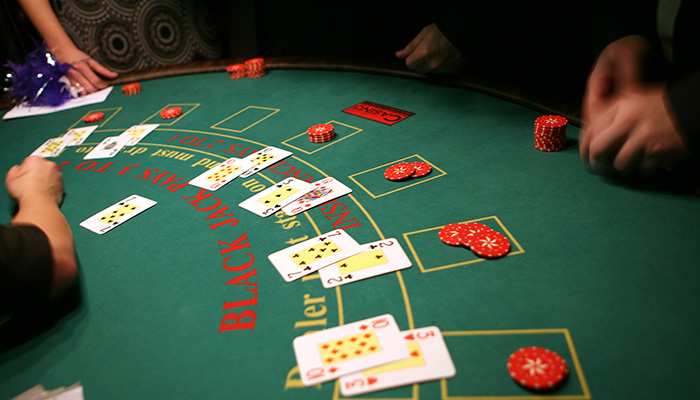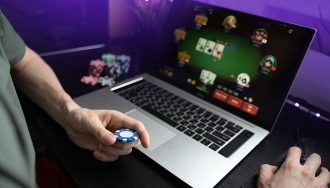Blackjack Terminology: Terms and Phrases You Need to Know
 Blackjack Terminology
Blackjack Terminology
- What Does “Bust Card in Blackjack” Mean?
- What Does “Push in Blackjack” Mean?
- Understanding the “Shoe” in Blackjack
- Explaining “Insurance in Blackjack”
- “Hit” in Blackjack Explained
- Explaining “Stand” in Blackjack
- “Soft Hand” vs. “Hard Hand”
Blackjack is one of the most popular casino table games, known for its easy-to-learn rules yet strategic complexity. However, with blackjack’s rising popularity comes an increasing amount of jargon that can confuse new players. In this blog post, we aim to break down some of the most common blackjack terms to help you develop a solid foundation before hitting the tables.
What Does “Bust Card in Blackjack” Mean?
The first term we will define is “bust card.” When the dealer or player exceeds 21 points in blackjack, this is known as “breaking” or “busting.” The card that caused the hand to bust by pushing the point total over 21 is called the bust card in blackjack.
For example, if the player has a hand worth 19 and hits, receiving a 3, this would bust the hand as the total would equal 22. So, in this scenario, the 3 is the bust card in blackjack. Busting results in an automatic loss for the player or dealer’s hand, regardless of the other’s point total.
Don’t forget, if you’re looking for the best blackjack sites in Michigan, you can find a list of recommended casinos right here on our site! All online casinos we recommend are hand-picked and tested extensively.
What Does “Push in Blackjack” Mean?
One outcome that can occur in blackjack is a “push.” A push in blackjack occurs when both the player’s and dealer’s hands are equal in point value. Neither hand wins nor loses in a push in blackjack.
For example, if the player is showing 18 points and the dealer also has 18, this would result in a push. The player’s bet is returned to them instead of being paid out for a win or taken by the house as a loss.
Pushes are essentially a tie, albeit an unsatisfying one for the player. While the player gets their original bet back, they are looking to win in blackjack, not just get their stake returned! However, a push is still better than losing the hand outright, don’t forget!
If the player busts and the dealer busts also, it does not result in a push. If this happens, the player will still lose their bet.
Understanding the “Shoe” in Blackjack
The shoe in blackjack is the dealing device used to distribute cards at a blackjack table. While a single deck of cards may be dealt manually, by hand, a shoe is usually brought in for multi-deck games. It allows for faster dealing, although it’s not without controversy!
The shoe is a box-like plastic device that holds 4, 6, or even 8 decks inside at a time. At brick-and-mortar casinos, the dealers load prepared shoe bricks by stacking the cards tightly together and inserting them into the dealing shoe. Cards are dealt one by one from the front of the shoe. When you play online blackjack there won’t be a shoe unless you’re playing a live dealer casino game.
Using a shoe in blackjack games has a few key advantages for both players and the house:
- Faster dealing – A shoe allows the dealer to distribute cards quickly using both hands without worrying about dealing with card stacks. This speeds up gameplay significantly.
- Increased randomness – With only one or two decks in play, card counting becomes easier for skilled players. The shoe mixes up more decks to make counting cards exponentially more difficult.
- Security – Shoes make it more challenging to manipulate stacks of cards through tricks like front-loading specific cards. Extra shuffled decks enhance game security.
However, the introduction of the shoe also influences the overall strategy of the game. For players, the increased number of decks can significantly alter the odds and probabilities of certain outcomes.
Basic blackjack strategy charts, which guide players on when to hit, stand, double down, or split, are affected by the number of decks in play. As the number of decks increases, the house edge can also shift, generally making it slightly more challenging for players to gain an advantage through card counting or other strategies.
Explaining “Insurance in Blackjack”
One of the unique rules in blackjack is the option to take “insurance” under certain circumstances. Insurance gives players a chance to protect their bets against the dealer potentially having natural blackjack.
Specifically, insurance comes into play when the dealer’s face-up card is an Ace. This card carries a high chance that the dealer’s hole card gives them a natural blackjack hand. The dealer will offer insurance when their upcard is an Ace, allowing players to place a side bet usually worth half their original bet.
For example, if you originally bet $20 on your hand and the dealer shows an Ace, you could now place a separate $10 insurance bet. Insurance pays out at 2:1 if the dealer then checks their hole card and reveals they do indeed have a blackjack.
The downside of insurance in blackjack is that you’re spending extra money for what is likely not needed in most cases. Dealers only have natural blackjack around 30% of the time when showing an Ace. Plus, if the dealer does not end up with blackjack, you lose your insurance bet and still have to play out your hand as normal.
“Hit” in Blackjack Explained
In blackjack, “hitting” refers to requesting an additional card for your hand. When playing a hand, you have the option to hit – be “dealt another card” – until you decide to stand on a hand value or go bust.
The decision to hit is based on your current hand value versus the dealer’s visible card. For example, if you have a 14 and the dealer has a 5, basic strategy says you should hit to try to get closer to 21 points without busting. The goal when hitting is to improve the value of your hand.
There are also scenarios where a player should not hit. For instance, if you are dealt an 18, there are only three cards that would benefit you; Ace, 2, and 3. Anything above a 3 would result in you going bust – so you shouldn’t hit. Taking another card risks going over 21 points and losing the hand immediately.
To hit properly in a blackjack game, you signal to the dealer you want another card by tapping the table behind your cards or clicking the virtual hit button. The dealer will then deal you one additional card to add to your hand total.
Understanding when to hit is a core blackjack strategic skill. By learning proper hitting technique and discipline, players can significantly reduce the house edge over thousands of hands. Check out the below basic strategy guide for when you should hit in blackjack, according to basic strategy:
| Player’s Hand Total | Dealer’s Up Card |
|---|---|
| 8 or less | 2 through A |
| 9 | 2 through 6 |
| 12 | 2, 3 or 7 through A |
| 13 through 16 | 7 through A |
Explaining “Stand” in Blackjack
In direct contrast to hitting, “standing” means not requesting any more cards for the current hand when you are satisfied with your point total. Indicating that you want to stand is essentially telling the dealer your hand is completed and ready to be compared to theirs.
Knowing when to stand comes down to understanding hand value probabilities related to the dealer’s upcard. After all, you don’t want to stand in a situation where drawing an additional card couldn’t result in you going bust, or when drawing has a statistical edge over standing.
For example, if you hold a hand worth 17 points and the dealer is showing a 7, statistically, standing here is the better choice. The dealer still has to take more cards, increasing their odds of going bust – and resulting in you winning the hand. However, this can change when your hand is soft – something we’ll cover in greater depth in the following section of this blog on blackjack terminology.
To properly stand in live blackjack games, wave your hand over the top of your cards. For online blackjack, click the virtual stand button on screen. Some online blackjack games have a unique “protection” mechanic in play too, that will display a warning message on your screen if you’re attempting to stand in a position where basic strategy says you shouldn’t.
Once all players stand, the dealer reveals their hole card and starts drawing more cards according to the table’s rules.
“Soft Hand” vs. “Hard Hand”
In blackjack strategy, hands fall into two primary categories – “hard hands” and “soft hands.” This classification comes down to whether an Ace is present and counting as 1 or 11 points. Understanding the blackjack terminology on soft versus hard impacts basic hit/stand decisions.
A hard hand simply means a hand with no Ace or an Ace counting only as 1 point instead of 11. For example, a hand made up of a 7 and Ace counting as just 1 has a hard total of 8 points.
Soft hands, on the other hand, contain an Ace counted as 11 points to start, which helps players avoid going bust. An Ace and 5 is a soft 16, for example. This means that even if you were to draw an additional card and go over 21, your hand wouldn’t bust. Instead, the Ace would simply change to be worth 1 point, and you’d essentially get a second chance. You could then choose to either draw one additional card or stand your hand.
The flexibility of soft hands in blackjack offers a strategic advantage. Players with a soft hand are in a position to take more risks without the immediate fear of busting. This is because the Ace can flip between 11 and 1, based on what the next card brings. If the next card causes the total to exceed 21, the Ace is counted as 1, bringing the total back down and offering a chance to adjust strategy mid-hand.
For instance, if you have a soft 17 (Ace and 6) and you decide to hit, drawing a 10 would normally bust a hard hand. However, in this scenario, the Ace adjusts to count as 1, turning the hand into a 17 (1+6+10). At this point, you could choose to stand, hoping the dealer has a lower total, or hit again if the rules and situation suggest a better outcome by taking another card.
Strategically, soft hands allow for aggressive play. When holding a soft hand, players are more likely to hit and improve their hand, especially when facing a dealer’s strong upcard (7 or higher). The logic is that the risk of busting is lower, and the potential to achieve a higher total is worth the additional card. This contrasts with hard hands, where the strategy often shifts towards caution, particularly with totals of 12 or higher, as the chance of busting increases significantly with each additional card drawn.




